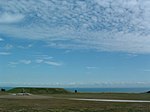Folkestone Warren
Geological Conservation Review sitesLocal Nature Reserves in KentNature Conservation Review sitesSites of Special Scientific Interest in Kent

Folkestone Warren is a 316.3-hectare (782-acre) biological and geological Site of Special Scientific Interest (SSSI) which runs along the coast between Folkestone and Dover in Kent. It is a Nature Conservation Review site and it contains three Geological Conservation Review sites and part of a fourth. An area of 83.6 hectares (207 acres) is a Local Nature Reserve,These chalk cliffs have several nationally rare plants and they provide a location for cliff nesting and wintering birds. The SSSI also contains two internationally important reference sites for study of the Cretaceous period.
Excerpt from the Wikipedia article Folkestone Warren (License: CC BY-SA 3.0, Authors, Images).Folkestone Warren
The Goat Path,
Geographical coordinates (GPS) Address Nearby Places Show on map
Geographical coordinates (GPS)
| Latitude | Longitude |
|---|---|
| N 51.099 ° | E 1.237 ° |
Address
The Goat Path
The Goat Path
CT18 7HZ , Hougham Without
England, United Kingdom
Open on Google Maps








